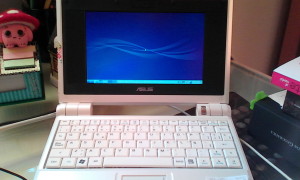Después de casi 10 años (yo es que cuido mucho el material :)) he sustituido el portátil del despacho por uno nuevo (un HP Probook 470 G5). Lo primero que he hecho ha sido cambiarle el sistema operativo, y estos son los pasos que he seguido para hacer una instalación live de Ubuntu Mate 16.04.3 desde un pendrive, que no es un proceso muy complicado… si todo va bien, claro 😛 , por eso el portátil no tiene ningún hardware muy exquisito, y la gráfica es Intel para evitar problemas.
- Descargar la .iso desde la página de Ubuntu Mate.
- Crear un pendrive USB live con esa .iso. Yo he utilizado el Creador de discos de arranque que viene instalado en el XUbuntu que tengo instalado en la máquina de casa.
- Insertar el pendrive live en el portátil donde se quiere instalar el Ubuntu Mate y arrancar. La secuencia de arranque de la UEFI que venía por defecto en el HP no tenía activada el arranque desde pendrive, así que he tenido que entrar en la UEFI (pulsando f2 continuamente al arrancar el portátil) y activarla.
- Reiniciar el equipo para que arranque desde el pendrive. Si todo ha ido bien, debería arrancar con Ubuntu.
- Cosas a comprobar antes de instalar definitivamente el sistema operativo: red y sonido. Si ambas cosas funcionan, hale, a instalarrrrr 🙂 Todo este proceso, es decir, los pasos del 1 al 5, me ha podido llevar una hora y media aproximadamente.
- Para terminar, una vez instalado el sistema operativo, haz una actualización del software con el gestor de paquetes Synaptic , para asegurarte así de que tienes la última versión de las aplicaciones incluidas en el sistema operativo. Esta actualización ha tardado una hora aproximadamente.
After 10 years (I care a lot about my stuff :)) I have changed my office laptop and now I got a HP Probook 470 G5. The first thing I did was to change the operative system, and these are the steps I have followed in order to make a live Ubuntu Mate 16.04.3 installation from a pendrive. As you can see it is not complicated… if everything goes ok, of course 😛 , that’s why I chose an Intel graphic card and no exquisite hardware for the laptop.
- Download the .iso from the Ubuntu Mate webpage.
- Create a USB live pendrive using that .iso. I have used the Startup disk creator included in the Xubuntu installed in my home laptop.
- Insert the pendrive in the laptop where you want to install Ubuntu Mate and then boot the computer. The default boot sequence of the HP’s UEFI did not included the pendrive, so I had to add it by entering into the UEFI (pressing f2 continuosly while the laptop boots).
- Reboot the laptop so it boots from the pendrive. If everything went ok, it should run Ubuntu.
- Before installing Ubuntu as your operative system, check if the network and the sound works. If so, proceed with the installation. This procedure, that is, steps 1 to 5, took about an hour and a half aprox.
- Finally, once you have installed the operative system, update the software using the Synaptic manager, to ensure you have the last versions of all the software in your laptop. This update took about one hour.


